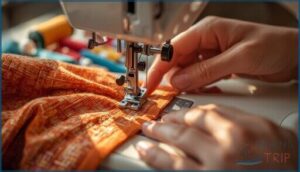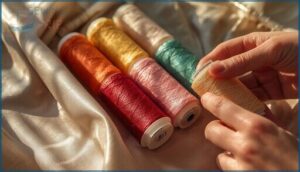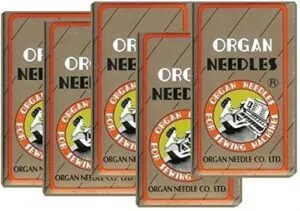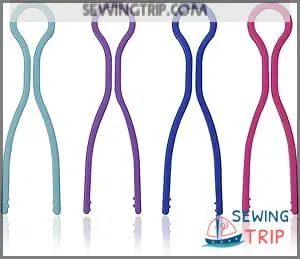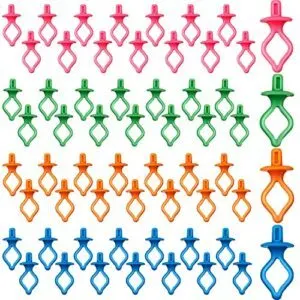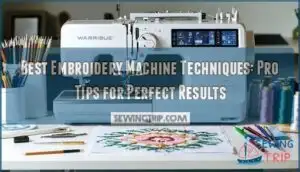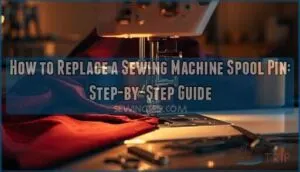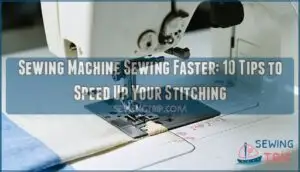This site is supported by our readers. We may earn a commission, at no cost to you, if you purchase through links.
Few things slow your sewing like a thread snapping mid-stitch. One moment, your machine hums along; the next, you’re rethreading and muttering under your breath. That sharp, familiar sound isn’t just frustrating—it chips away at your confidence, interrupts your flow, and can even leave marks on fabric you’ve worked hard to prepare.
Reducing thread breakage isn’t luck or guesswork; it’s about making deliberate choices with your machine, your materials, and your hands. Small changes, from the needle you choose to the way you wind your bobbin, add up fast—turning breakdowns into smooth, steady sewing.
Table Of Contents
Key Takeaways
- Always use the correct needle, thread, and tension settings for your fabric to prevent most thread breakage.
- Regular cleaning and maintenance of your sewing machine keep threads running smoothly and minimize sudden breaks.
- Proper storage and inspection of threads protect them from damage, moisture, and age-related weakness.
- Slow, steady sewing and careful fabric handling reduce stress on both thread and machine, resulting in fewer interruptions.
Essential Tips to Prevent Thread Breakage
Thread breakage can slow you down and really test your patience. The good news is there are a handful of practical steps you can take right now to keep things running smoothly.
Here’s what you need to know to prevent unnecessary thread trouble.
Correct Threading Techniques
Even if you’re careful, a single misstep with Upper Threading or Bobbin Insertion throws everything off. Improper Threading invites headaches and breaks. Sometimes, Rethreading The Machine from scratch is the best solution.
Follow each Thread Guide and always seat thread firmly in the Take-Up Lever and Tension Discs. Use the correct threading technique every single time—it’s your best defense.
Regular cleaning can help prevent thread jam prevention.
Balancing Tension Settings
Balanced stitches start with the right tension. Adjusting your upper tension and bobbin tension to suit your fabric type and thread weight makes all the difference.
Tension testing—a few lines on scrap fabric—shows if your thread tension needs tweaking. Your stitch line should look smooth on both sides. Thread tension is a balance between the top thread and bobbin thread.
Proper tension settings reduce thread breakage and make sewing stress-free.
Selecting Proper Needle Size and Type
Getting tension right is only part of the battle. The wrong needle—too small for your thread, too large for your fabric—leads to breakage or thread fraying.
Choosing the correct needle means matching needle size and needle type with your fabric compatibility and thread matching in mind.
Needle wear effects add up, so regular needle replacement heads off stubborn problems before they start.
Adjusting Sewing Speed and Fabric Handling
You can dodge a lot of thread breakage by tweaking how you handle speed and fabric. For smoother runs, ease into high sewing speed instead of gunning it from the start. Try these habits:
- Gradual acceleration
- Consistent fabric stabilization
- Dialing in ideal sewing speed for material compatibility
- Correct spool orientation
- Adjusting sewing technique as you work
Regular Cleaning and Maintenance
Regular machine maintenance isn’t just a chore—it’s a game changer. Make a habit of cleaning dust and lint buildup from tension discs and bobbin areas every week, or after sessions with linty fabrics.
Treat regular machine cleaning as your secret weapon—removing dust and lint often keeps your sewing running smooth and trouble-free
Use soft brushes, canned air, and oil moving parts monthly for most machines. Prioritize high thread quality and adopt consistent cleaning routines to avoid costly breakdowns.
Troubleshooting Common Thread Breakage Causes
Thread breakage can come from many directions, but a few culprits show up again and again. Knowing what to watch for helps you spot trouble as soon as it starts.
Here’s what you need to look out for next.
Identifying Upper Thread Vs. Bobbin Thread Breakage
Spotting the culprit comes down to details—thread tails and Stitch Appearance hold clues. Thread tails on top signal Upper Thread Breakage, while tails beneath point to Bobbin Thread Breakage. Look for thread bunching or looping under the fabric and color mismatches.
Identifying the type of thread breakage helps you zero in on tension imbalance or needle issues fast when troubleshooting thread breakage.
Recognizing Tension and Thread Quality Issues
Ever wonder why your thread keeps snapping? Watch for inconsistent tension signs like stitch unevenness, loops, or puckering—these often stem from trouble spots in thread tension or poor thread quality.
If you notice breakage patterns every few inches or see lint buildup, you’re likely facing thread defects or tension setting problems. Troubleshooting thread breakage starts here.
Diagnosing Needle and Bobbin Problems
Stubborn thread breaks often go back to hidden Needle Problems or subtle Bobbin Issues. If you’re using the wrong Needle Size or ignoring Bobbin Tension and Bobbin Condition, trouble is sure to follow.
Bent or dull needles and damaged bobbins cause classic headaches—snagging, shredding, inconsistent stitches.
Fixing Needle and Bobbin Issues quickly restores thread compatibility and banishes these common problems.
Detecting Environmental and Operational Factors
Ever wonder why thread snaps at the worst time? Too much humidity, rising temperatures, or a dusty workspace will do it every time. Keep breakdowns at bay by:
- Monitoring humidity and temperature
- Checking for lint and debris
- Scheduling machine maintenance
- Evaluating thread age and storage
Catch these culprits early—they’re often behind persistent thread breakage you’re troubleshooting.
Choosing Quality Threads and Materials
Getting the right threads and materials is one of the best ways to keep breakage in check. A few simple habits and careful choices can make all the difference.
Here’s what to pay attention to as you choose and handle your supplies.
Thread Material Selection (Cotton, Polyester, Specialty)
Which thread do you trust to hold everything together? Your Thread Material selection directly shapes sewing results.
Cotton Threads provide stable seams—best for quilting—but lack stretch and environmental resistance. Polyester thread benefits shine in strength, durability, and flexibility for knits and activewear. Specialty thread types address unique needs—from fire-resistance to conductivity.
Compare below to guide your Thread Type Selection:
| Thread Type | Material Tensile Strength / Use |
|---|---|
| Cotton | Low, best for minimal stretch fabrics |
| Polyester | High, excels in strength and flexibility |
| Specialty | Purpose-built, e.g. fire-resistant |
| 100% Poly | Enhanced environmental resistance |
Storing Threads for Longevity
After settling on the right thread material, keeping it in good condition depends on how you store materials properly. For best thread storage and longer shelf life, remember:
- Use opaque containers to limit light exposure.
- Keep humidity controlled.
- Avoid heat sources.
- Clean threads before storing.
- Rotate stock to maintain thread condition and weaving performance.
Inspecting Threads for Damage or Wear
Once your threads are stored in good condition, set aside time for visual thread checks. Look for fraying, worn spots, or defect impacts—the telltale signs of poor thread quality or storage.
Use wear measurement tools or automated detection systems if available. Following industry standards on inspection ensures only the strongest thread material touches your machine, protecting every weave.
Understanding The Impact of Thread Lubrication
After checking for damaged spots, pay attention to friction reduction—a thread lubricant or sewing machine oil is your friend here. The right amount keeps everything clean and lubricated, so your thread glides smoothly.
With improved strength retention and machine efficiency, ideal lubricant parameters mean fewer breaks and longer thread life, protecting your budget and your peace of mind where cost efficiency counts.
Top Products to Reduce Thread Breakage
The right tools make it easier to prevent thread breakage and keep your sewing running smoothly. Choosing products designed for reliability and consistency can make a real difference.
Here are some of the top options worth having at your side.
1. Schmetz Universal Sewing Machine Needles Assorted
If you’re after brand reliability and fewer thread breaks, Schmetz Universal Sewing Machine Needles Assorted bring real peace of mind. Needle size matters—these packs cover popular sizes for a reason, giving you the right tool for both woven and knit fabrics.
You’ll notice crisper stitch quality and longer needle lifespan, especially compared to brands that dull quicker. Their smooth eyes reduce snags, while routine needle replacement ensures your machine stays clear of trouble.
Stop wrestling with a bent or dull needle and control the outcome with smart needle selection.
Best For: Anyone who sews at home and wants reliable needles that work well with both woven and knit fabrics, minimizing thread breakage and hassle.
- Fits almost all household sewing machines and covers commonly used sizes.
- Lasts much longer than generic brands and delivers consistently smooth stitching.
- Reduces thread fraying and skipped stitches, making sewing more enjoyable.
- Not suitable for industrial or specialty sewing machines.
- May break when used on extra-thick fabrics or if not replaced regularly.
- Rare quality control issues can occur, like isolated tip defects.
2. Sewing Machine Needles Assortment Sizes Variety
Precision in your sewing toolkit starts with a good Needle Size Guide and an assortment pack that has your back. Fabric Needle Pairing gets easier when you’ve got Needle Type Variety—these Beginner Needle Packs cover sizes and styles from delicate sheers to mid-weight cottons.
Assortment Pack Benefits? You always have the right Sewing Machine Needles on hand. Smart Needle Selection and steady Needle Replacement help sidestep issues from a bent or dull needle. With the right pack, perfect stitching comes naturally.
Best For: Home sewers and crafters who want an easy, affordable way to handle most fabric types without hassle.
- Wide range of needle sizes covers basic to heavy fabrics, making it versatile for many projects.
- Clear assortment keeps replacements handy, reducing downtime and frustration.
- Great value set—ideal for both beginners and experienced hobbyists.
- Not designed for industrial or heavy-duty sewing machines.
- Needle quality can vary compared to premium brands, with some reports of dull or blunt tips.
- Limited to standard sizes and types, so specialized sewing needs may require separate purchases.
3. Prewound Bobbins Size A Sewing Embroidery
Smooth sewing depends on more than needle choice—it comes down to your bobbin. Prewound bobbins, especially Size A, deliver enhanced thread capacity so you won’t pause mid-project.
You’ll notice fewer bobbin issues because these offer uniform winding for consistent bobbin thread tension.
If you run an embroidery machine, count on the prewound material durability to prevent thread breakage during demanding runs. Widespread industry adoption trends only reinforce their reliability, making machine compatibility and easy integration a major win for simple, professional stitching.
Best For: Home and commercial sewists who want hassle-free, consistent embroidery and sewing with minimal interruptions.
- Uniform winding delivers reliable tension and reduces skipped stitches.
- Increased thread capacity means fewer bobbin changes and longer runs.
- Works with most popular embroidery machines, saving both time and effort.
- May not fit all machine models; always double-check compatibility.
- Some users have reported occasional thread breakage or tangling.
- Quality can vary by batch, possibly causing inconsistent results.
4. Bobbin Buddies Thread Spool Organizers
A cluttered drawer costs you time and thread condition. Bobbin Buddies thread spool organizers tackle that head-on. They snap bobbins right onto their matching spools for fast access and error-free color matching, helping you avoid tangles and save an average of eight minutes per project.
Thanks to durability testing with flexible silicone, these organizers hold up through hundreds of uses. High thread compatibility means you’ll see better storage efficiency, easier thread management, and less waste—delivering true financial impact in any sewing setup.
Best For: Crafters who want easy, color-matched thread organization and faster project prep without fuss.
- Cuts down time spent searching and untangling thread by pairing bobbins with their spools.
- Fits most standard thread types, with durable silicone that lasts through frequent use.
- Helps keep sewing spaces neater and prevents waste from tangled or mismatched threads.
- Doesn’t work with large embroidery cones or pegged thread holders.
- Prongs may be too long for some thread racks, complicating storage.
- Storage tin or solution sold separately, so you need your own way to keep them organized.
5. Willbond Bobbin Holders Thread Spool Clips
Ever wish your bobbin chaos could be tamed with a clever clip? Willbond Bobbin Holders Thread Spool Clips answer that call. Clip color-coding makes quick work of matching bobbin thread to its spool. Wide spool compatibility means no lost time hunting for a fit.
Their flexible build keeps bobbins paired tightly—dramatically boosting your organizational efficiency and slashing thread waste. Strong market performance and long product life make sure you’re investing in lasting bobbin care, especially if you’re prone to bobbin thread issues.
Best For: Sewing, quilting, and embroidery enthusiasts who want to organize their bobbins and threads quickly with color-coded clips.
- Color-coded clips make it easy to match and find the right bobbin for each spool.
- Flexible silicone fits most standard bobbins and lasts for years without breaking.
- Reduces thread tangles and helps keep sewing workspaces neat.
- May not fit very small or extra-large spools.
- Can be too long for some smaller spool holders or tight organizers.
- Color may look different in person due to screen variations.
Frequently Asked Questions (FAQs)
How does ambient humidity affect sewing thread strength?
Humidity’s tensile impact on sewing thread depends on the material. Cotton loses strength and becomes prone to breakage in high humidity, while polyester stays strong.
Proper thread storage within recommended humidity ranges helps preserve condition and overall thread quality.
What training reduces operator-related thread breakage?
Teaching correct threading techniques is like dialing in your radio—precision matters.
Training focused on threading tips, tension adjustments, needle selection, speed control, and maintenance protocols helps you master machine features and prevent costly mistakes.
Can thread age or storage conditions impact durability?
Thread shelf life isn’t endless—storing thread in hot, humid places leads to material degradation, visible aging signs, and higher breakage rates.
Good thread storage, like cool and dry conditions, preserves thread quality and condition over time.
How do spinning speeds influence end-break rates?
Like revving an engine too hard, increasing spindle speed, rotor speed, or delivery speed cranks up thread breakage.
Higher speeds strain yarn, shift statistical behavior, and demand real attention to tension settings, sewing speed, and operational strategies for control.
What are signs of excess thread lubricant in use?
When excess thread lubricant is present, you’ll often notice fabric staining, machine jamming, seam slippage, messy work areas, and even a rise in thread breakage.
These issues waste materials and increase workplace hazards and economic costs.
Conclusion
Strange as it sounds, reducing thread breakage means slowing down to speed up. Every time you pause to pick the right thread or tweak the tension, you’re building momentum for every future stitch.
Mastery in sewing hides inside these tiny, careful choices that most skip. Give attention to small details now, and your machine will answer with calm, reliable performance.
Let every break become your teacher, until smooth stitching becomes your everyday standard—never a rare event.
- https://textilelearner.net/yarn-breakage-in-ring-frame-mechanism-reasons-and-control/
- https://www.sciencedirect.com/topics/engineering/end-breakage-rate
- https://www.boshitex.com/news/576.html
- https://www.digitizingusa.com/showblog/why-does-my-top-thread-keep-breaking
- https://textileebooksforu.blogspot.com/2019/08/how-to-control-ringframe-end-breakages.html



